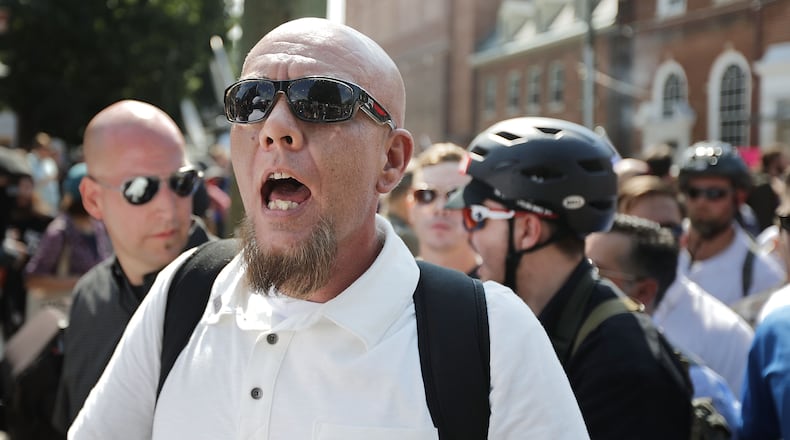For decades, the style of white supremacists had a predominant image -- a conical hood with cutout eyes and a long robe, most often in white, but sometimes in black or other colors. This costume, the widely recognized robes of the second Ku Klux Klan, dominated the early 20th century.
Before 1915, while some Klan members did wear hoods and robes, their uniform wasn't consistent. Klan members also relied on folk traditions to guide their mode of dress wearing fake beards, animal horns, blackface or cross dressing when rallying or intimidating victims.
Not having a set uniform made it easier to explain away their brutal acts as boyhood shenanigans and with the broad political and public support they enjoyed at the time, there was no need to dress up, said Alison Kinney, author of Hood (Bloomsbury, $15). Back then, every single member of the community showed up for public lynchings dressed as if it were just another day in the park.
Last weekend, when supporters of neo-Nazi, White nationalist and Ku Klux Klan ideology descended on Charlottesville, Va. for the "Unite the Right" rally, they appeared to be taking a sartorial trip back to the 19th Century. By holding loosely to a uniform of knit polo shirts and khaki pants, they aspired to look more like everyday people than the horned, hooded figures of yesterday.
"They have been emboldened by Trump," said Kinney. "It reminds me of the way that white supremacy in the U.S. since the Reconstruction Era has enabled people to go and be photographed in the everyday public."
But even in the old days, the hoods and robes weren't used to hide. "The hood wasn't there so much as to help them hide their identity, as to make them feel as if they were members of a fraternity or a boy's club," Kinney said.
The look went mainstream when Hollywood intervened, most notably in D.W. Griffiths 1915 film "Birth of a Nation," Kinney said. Around the time of the movie's Atlanta premiere, the same year Leo Frank was lynched by a mob of angry whites, a former Georgia minister, William J. Simmons, kicked off the second Ku Klux Klan with a cross burning at Stone Mountain.
In 1921, the Klan opened Gates City Manufacturing Company in Atlanta to mass-produce designs featured in "Birth of a Nation" including robes and banners that were available through mail-order.
While hoods and robes will always have a place among Klan members, it's just as likely today that the fascist in the crowd is wearing Fred Perry, New Balance or maybe even Gucci.
The new look of white nationalism has brought a fresh problem for brands. What do you do when your product becomes the gear of choice for promoters of hate?
For many years, Fred Perry polos have been the preferred shirt for white nationalists. It's a play that Americans took from their European comrades who began wearing the brand in the 1960s as a dig on British elitism. The brand became so enmeshed with hate groups that the Southern Poverty Law Center includes Fred Perry in its Racist Skinhead glossary . Dr. Martens, the brand of German work boots founded in 1947, are also on that list.
In July, John Flynn, chairman of Fred Perry gave a statement to a Canadian radio outlet about the matter . "No, we don't support the ideals or the group that you speak of. It is counter to our beliefs and the people we work with," he said.
Last year, New Balance took a similar strategy after a popular neo-Nazi website declared New Balance the shoes of white people. And this week, in response to the Tiki torch wielding protesters in Charlottesville, Tiki Brand did the same. "TIKI Brand is not associated in any way with the events that took place in Charlottesville and are deeply saddened and disappointed. We do not support their message or the use of our products in this way," wrote the company in a post on Facebook.
Gucci had a problem of another sort when a Twitter user posted an image of alleged Gucci employees in Trump Tower holding signs that read, "Hate has no home here." When the image appeared online at Jezebel.com, Gucci sent urgent emails to the website denying that the individuals were employees .
This new look of the alt-right has a purpose -- to offer up a clean-cut, normalized image of white supremacy, leaving the hoods and robes of the Klan feeling more like museum ready artifacts.
The overseas market is dead and most of his orders come around Halloween, he said. While the traditional hoods and robes can still be spotted during ceremonies or protests, Bondira said he tells the various Klan groups who contact him that such grand public rallies are a thing of the past.
About the Author
The Latest
Featured


